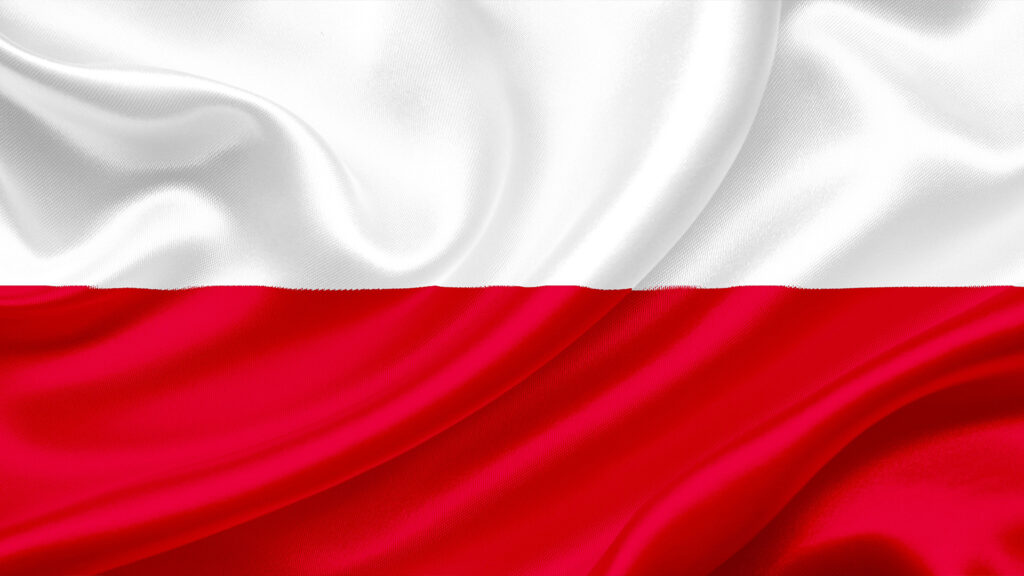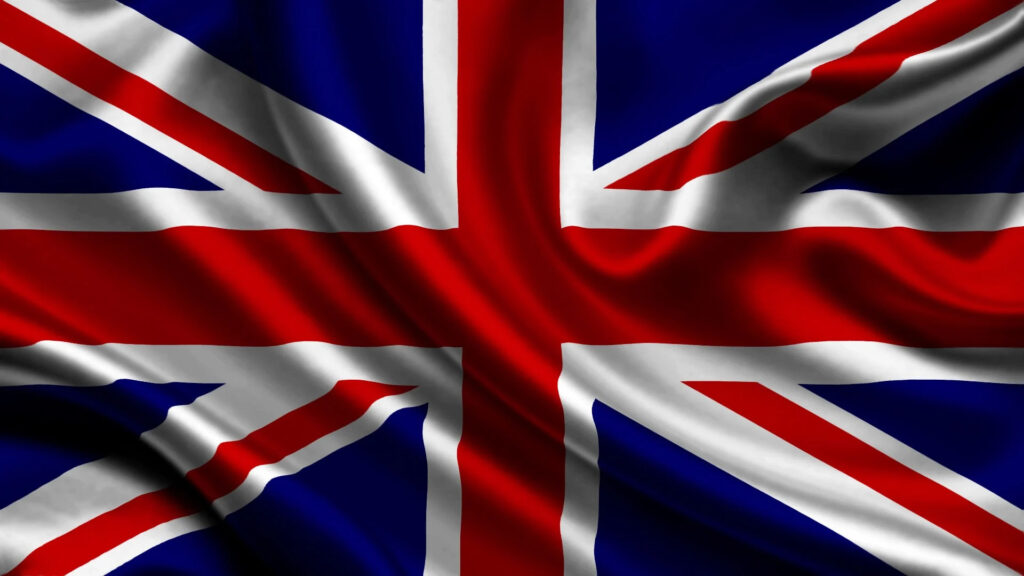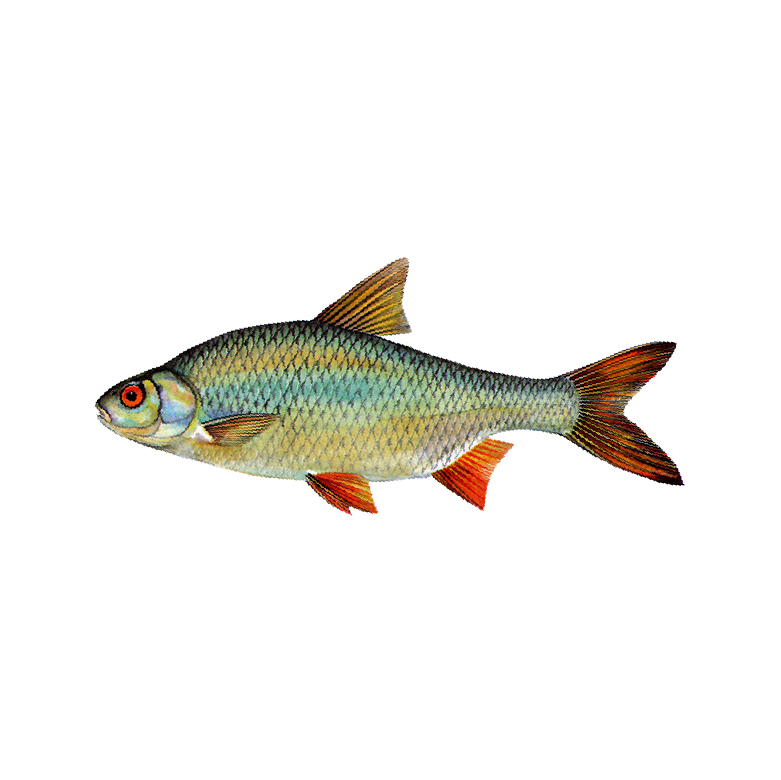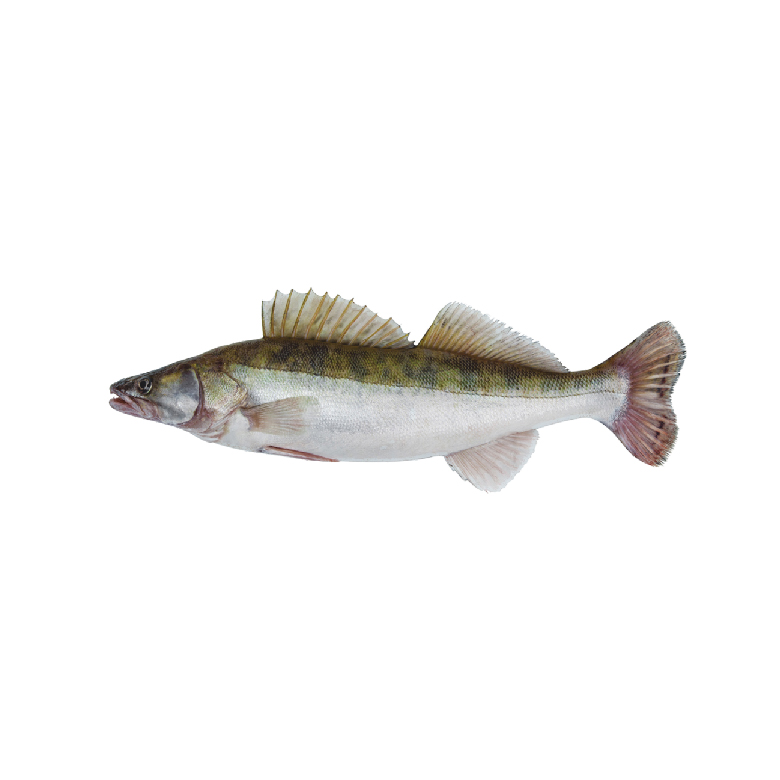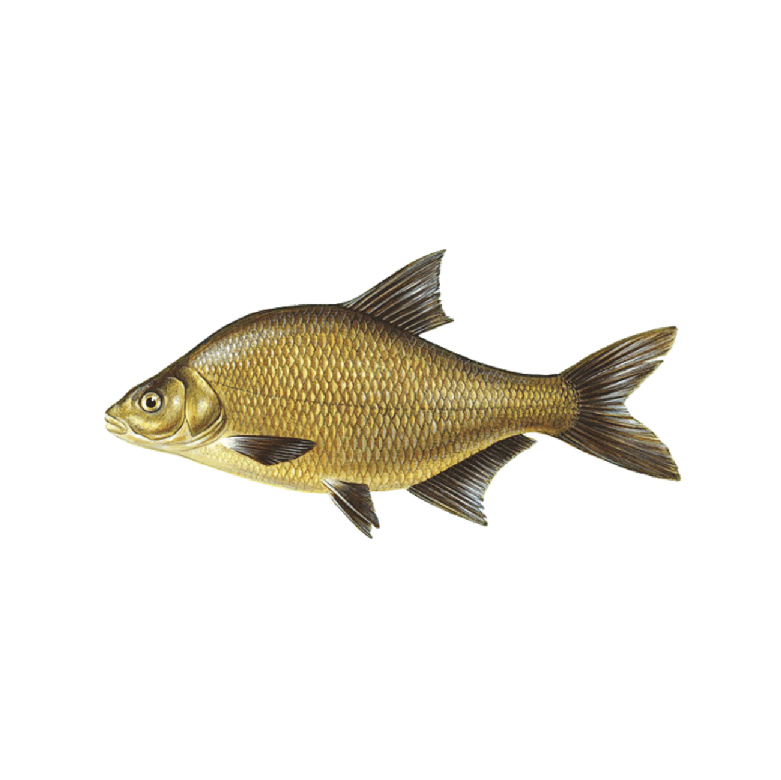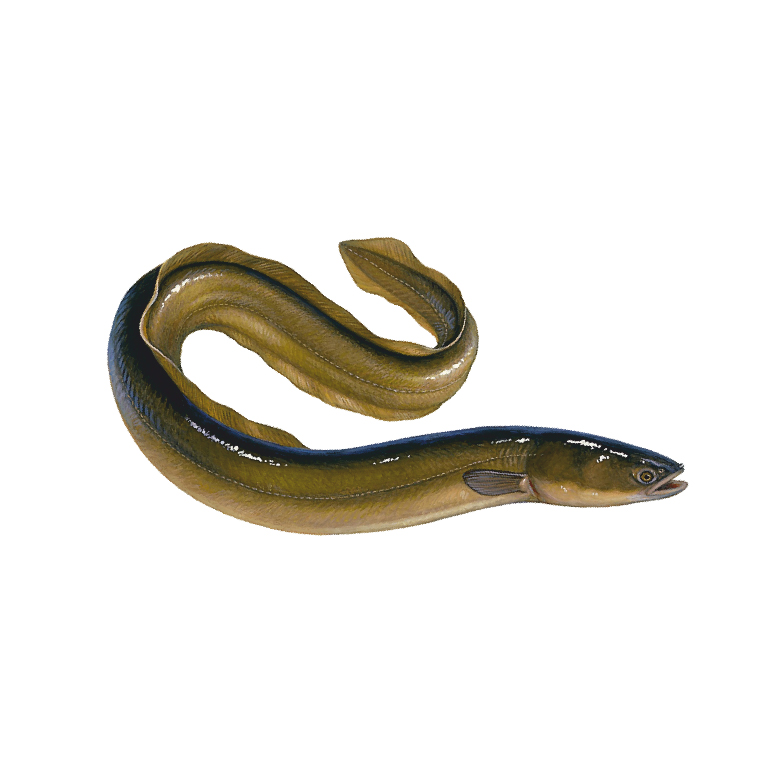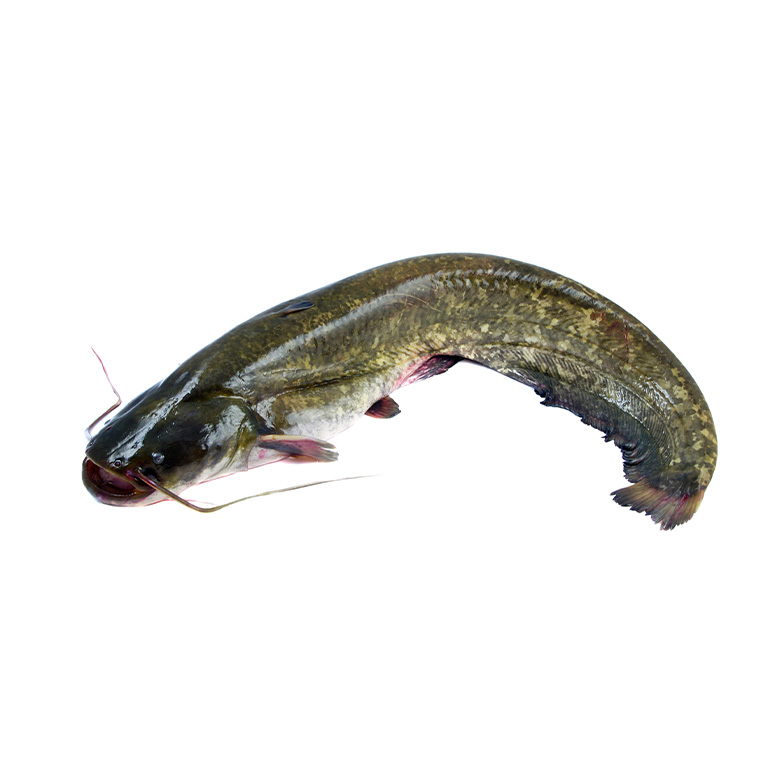Fish
Anatomy and appearance. The roach is a fish from the carp family. The body is laterally compressed and short. Its short-base dorsal fin is situated almost in line with the ventral fins. The roach’s back is dark in colour, its belly and sides are silver-white, and its ventral and anal fins are red.
Way of life. Young roaches live in flocks. They are mainly found in the coastal zone. Adults inhabit deeper zones, feeding in the depths of the water and near the bottom.
Reproduction. Depending on their age, roaches can lay up to 150,000 eggs.
Spawning type: phytophilous.
Distribution and habitat. Roaches inhabit lakes, rivers, streams and also coastal marine waters. The roach is found in almost all of Europe, in the catchment areas of the Black Sea, the Caspian Sea and the Aral Sea.
Fun fact. Roaches are the most commonly caught fish by anglers.
Roach is a fish characterised by its bony, white and tender meat. It is one of the leanest fish swimming in our region. Its consumption is recommended for people on a low-calorie diet, e.g. diabetics, people with high blood pressure…
This fish is an excellent source of protein and B vitamins – it contains mostly vitamins B3 and B12, which are responsible for proper memory and concentration, as well as relieving stress and improving mood.
Roach is also a source of phosphorus, potassium, calcium and iron. At the same time, the flesh of this fish contains polyunsaturated PUFA acids, which are responsible for the correct functioning of the retina, they nourish the brain and inhibit inflammatory processes in the body’s cells.
Roach is also a source of a rare element – selenium, which shields cells from the effects of free radicals. It is important to remember that low levels of selenium in the body carry a risk of bladder cancer, among other diseases.
Nutritional values (100g):
Energy: 90kcal/100g
Protein: 20g/100g
Fat: 1g/100g
Polyunsaturated acids: 57%
Vitamin B12: 1,9 μg
Vitamin D: 11,6 μg
Phosphorus: 241 mg
Selenium: 23.6 μg
Vitamin B6: 0,2 mg
Niacin: 4,6 mg
Calcium: 12 mg
Iron: 0,4 mg
Magnesium: 24 mg
Phosphorus: 241 mg
Potassium: 321 mg
Sodium: 41 mg
Zinc: 0.6 mg
Copper: 0.1 mg
Manganese: 0,1 mg
Selenium: 23,6 μg
Anatomy and appearance. The perch is a fish of the perch family. It has a laterally compressed body, relatively long. The mouth is large, the two dorsal fins are close together, the first dorsal fin is high and composed of hard rays, the second fin is lower and shorter, soft. The body is greenish yellow, the back darker, the anal fin, caudal fin and ventral fins red or orange.
Way of life. Adult perch are predators, hunting in packs
Reproduction. Depending on their age, perch lay from several hundred thousand to one million eggs.
Spawning type: eggs are laid on substrate e.g. twigs, vegetation in the form of long streamers.
Distribution and habitat. Perch inhabit fresh waters: lakes, rivers and brackish waters.
Perch inhabit almost all of Europe, North America and northern Asia
Fun fact. Perch have tasty lean meat. They feed all year round and are cannibals.
Perch is a lean fish in which we find a high content of Omega3 fatty acids. It is also a great source of complete protein. By consuming perch regularly, we provide our body with a good dose of vitamin D, which strengthens bones, aids metabolism and supports cardiovascular function….
It is also worth remembering that perch is a fish with anti-cancer properties.
In addition, the vitamin B6 found in perch supports the synthesis of hormones and enzymes. By regulating blood pressure, it influences heart and brain function and provokes the body to produce haemoglobin, which oxygenates body cells.
The leucine found in perch increases the body’s performance, aids regeneration, accelerates the process of building muscles and stabilises blood sugar levels. Meanwhile, lysine, which is abundant in perch, prevents chronic fatigue, dizziness, herpes, hair loss or anaemia. An additional benefit of eating perch is the replenishment of the element selenium, which supports immunity – protecting cells from bacteria and viruses.
Nutritional values (100 g):
Energy (kcal)81 kcal
Protein (g)18.4 g
Fat (g)0.8 g
Cholesterol (mg)72 mg
Sodium (mg)47 mg
Salt (g)0.118 g
Potassium (mg)330 mg
Calcium (mg)20 mg
Phosphorus (mg)220 mg
Magnesium (mg)26 mg
Iron (mg)0.6 mg
Zinc (mg)0.81 mg
Copper (mg)0.04 mg
Manganese (mg)0.06 mg
Iodine (μg)4 μg
Vitamin A (μg)7 μg
Retinol (μg)7 μg
Vitamin D (μg)0.8 μg
Vitamin E (mg)1.47 mg
Thiamine (mg)0.075 mg
Riboflavin (mg)0.12 mg
Niacin (mg)3 mg
Vitamin B6 (mg)0.3 mg
Folate (μg)9 μg
Vitamin B12 (μg)5 μg
Vitamin C (mg)1.3 mg
Total saturated fatty acids (g)0.13 g
Total monounsaturated fatty acids (g)0.09 g
Total n-3 (g)0.06 g
Total n-6 (g)0.01 g
Polyunsaturated fatty acids (g)0.07 g
Isoleucine (mg)1028 mg
Leucine (mg)1568 mg
Lysine (mg)1908 mg
Anatomy and appearance. A fish from the perch family. Its body is elongated, short, slightly laterally flattened, with green-grey back, paler sides, white belly, and 8 to 12 brown-black streaks on the sides. Zander has two dorsal fins, the first hard and the second soft. There are dark spots on the dorsal and caudal fins, forming longitudinal bands. The pectoral, ventral and anal fins are bright. The pectoral fins are rounded, of similar length to the ventral fins. Zander’s scales are thin and it has relatively few bones.
Way of life. Zander is a predatory fish, sees very well at night, has an excellent sense of smell and a very good sense of the lateral line. It can usually be found at the bottom of a body of water. This species feeds most intensively in summer.
Reproduction. Depending on their age, zanders lay between 150,000 and 900,000 eggs.
Spawning type: phytophilous and lithophilous.
Distribution and habitat. Zander inhabits mainly fresh waters, the lower reaches of rivers and relatively shallow and extensive lakes. It can also be found in brackish sea bays.
It is found in the catchment areas of the Baltic Sea, the Black Sea, the Caspian Sea and the Aral Sea.
Fun fact. Zander attacks its prey by surprise and chases it at high speed.
These fish are protective parents, as the males of the species defend the deposited eggs and offspring from predators.
Zander is sensitive to pollution and needs a high oxygen content in the water.
Zander is a species of freshwater fish from the perch family and is very rich in high-quality protein that contains all the essential amino acids. This protein is important for tissue growth and regeneration, as well as for maintaining muscle strength…
For a change, zander contains low amounts of cholesterol, so it should be regularly consumed by people struggling with atherosclerosis, stroke or Leśniewski-Crohn’s disease.
It is a low-fat fish, so it is a good choice for those on a reduction diet.
Zander is an excellent source of polyunsaturated fatty acids, which have a health-promoting effect – particularly in terms of the cardiovascular system.
Zander’s meat is rich in selenium, vitamin D and B12, which supports the formation of red blood cells in the body, protecting against anemia.
Nutritional values (100g):
Energy (kcal) 83 kcal
Protein (g)19.2 g
Fat (g)0.7 g
Cholesterol (mg)60 mg
Water (g)78.9 g
Sodium (mg)57mg
Salt (g)0.143 g
Potassium (mg)340 mg
Calcium (mg)49 mg
Phosphorus (mg)220 mg
Magnesium (mg)29 mg
Iron (mg)0.8 mg
Zinc (mg)0.57 mg
Copper (mg)0.04 mg
Manganese (mg)0.05 mg
Vitamin A (μg)9 μg
Retinol (μg)9 μg
Vitamin D (μg)0.7μg
Vitamin E (mg)1.26 mg
Thiamine (mg)0.16 mg
Riboflavin (mg)0.25 mg
Niacin (mg)2.3 mg
Vitamin B6 (mg)0.3 mg
Folates (μg)12 μg
Vitamin B12 (μg)5 μg
Vitamin C (mg)1 mg
Total saturated fatty acids (g)0.14 g
Total monounsaturated fatty acids (g)0.16 g
Polyunsaturated fatty acids (g)0.19 g
Isoleucine (mg)1005 mg
Leucine (mg)1528 mg
Lysine (mg)1528 mg
Anatomy and appearance. A fish from the carp family.
The body of the bream is strongly ridged and laterally flattened, the head is small, with axillary processes at the base of the ventral fins. The anal fin has a long base, the body colouration is golden brown or grey, the back is dark brown to black, the pectoral fins are black, the base of the fins is orange
Way of life. The bream is a gregarious fish, with adults mainly found near the bottom of bodies of water, where they feed extensively.
Reproduction. Depending on age, between 15,000 and 90,000 eggs.
Spawning type: phytophilous
Distribution and habitat. The bream inhabits fresh waters: lakes, lowland rivers, dammed reservoirs, and can also be found in coastal brackish sea waters. The fish inhabits almost all of Europe and parts of south-west Asia.
Fun fact. The bream’s snout can extend into a characteristic ‘trumpet’ to help it scour the water body bottom for food.
High-quality protein is an important nutrient found in bream. This protein contains all the essential amino acids that the body must obtain from food, as it cannot synthesise them on its own….
Bream also contains omega-3 fatty acids, which are essential for the heart and the circulatory system. They lower cholesterol levels, reduce the risk of cardiovascular disease, improve brain function and reduce inflammation in the body.
Bream is also rich in vitamins such as vitamin D, vitamin B12 and vitamin B6.
Vitamin D is important for bone and dental health, as well as for the proper functioning of the immune system. Vitamin B12 supports red blood cell production and maintains nervous system health, while vitamin B6 is important for hormone production and functioning of the nervous system.
Bream is also a good source of minerals such as phosphorus, selenium and potassium. Phosphorus is important for bone and tooth health, as well as for muscle and nerve function. Selenium supports the immune system and helps with protecting the body from harmful free radicals, while potassium affects the functioning of the heart and nervous system.
In Poland, bream is considered one of the most important fish in traditional cuisine, especially at Christmas.
Energy: 105kcal/100g
Protein: 17g/100g
Fat: 4.5g/100g
Vitamin B12: 1.3 μg
Vitamin D: 7,6 μg
Phosphorus: 239 mg
Selenium: 16,7 μg
Vitamin B6: 0,2 mg
Niacin: 3,9 mg
Calcium: 19 mg
Iron: 0,6 mg
Magnesium: 27 mg
Phosphorus: 239 mg
Potassium: 309 mg
Sodium: 40 mg
Zinc: 0.4 mg
Copper: 0.1 mg
Manganese: 0,1 mg
Selenium: 16,7 μg
Anatomy and appearance. A fish from the carp family.
Tench has a stocky body. The tail shaft is broad and short. It has short whiskers at the corners of the mouth. The scales are small and embedded deep in the skin. The back of the fish is dark brown, the sides are greenish with a golden sheen, the fins are rounded and dark in colour.
Way of life. Tenches feed mainly in the coastal zone, they love overgrown areas (among vegetation), and are very tolerant of low oxygen levels in the water
Reproduction. Depending on their age, tenches lay from several hundred thousand to one million eggs.
Spawning type: phytophilous
Distribution and habitat. Tench is a freshwater fish, inhabiting ponds, lakes and lowland rivers, with low oxygen requirements, preferring shallow pools with muddy bottoms covered with rich vegetation.
The tench inhabits almost all of Europe, as well as the waters of Siberia.
Fun fact. Male tenches, compared to females, have longer ventral fins.
Tench is a medium-fat fish with a sweetish taste and aroma. It is low in calories and a good source of protein, making it an ideal choice for people who want to maintain a healthy weight. Tench is eagerly eaten due to its tasty, white and tender meat. It can be served to young children and the elderly….
Read more…
The healthy fats contained in tench are beneficial for heart health, as they help to reduce bad cholesterol and increase good cholesterol. Additionally, the EPA and DHA acids are beneficial for brain and nervous system function.
This fish also provides many minerals such as magnesium, iron, phosphorus, calcium, fluorine, cobalt, sulphur, chromium, potassium, selenium and copper. Its flesh is also a veritable wealth of B vitamins (especially B1, B2, B3 and B6, B9 and B12) and A, D, E, C, PP. The latter, vitamin PP, helps to convert carbohydrates, fats and proteins into energy and will therefore have an excellent effect on metabolism. In addition, it can help to regulate blood sugar levels, which is particularly important for people with diabetes. Vitamin PP also has an impact on skin health – it improves skin condition, smooths and moisturises the skin.
Nutritional values (100g):
Energy: 79kcal/100g
Protein: 13g/100g
Fat: 3g/100g
Vitamin B12: 2,5 μg
Vitamin D: 11,5 μg
Phosphorus: 218 mg
Selenium: 36.8 μg
Vitamin B6: 0,3 mg
Niacin: 3,2 mg
Calcium: 12 mg
Iron: 0,4 mg
Magnesium: 28 mg
Phosphorus: 218 mg
Potassium: 347 mg
Sodium: 49 mg
Zinc: 0.4 mg
Copper: 0.1 mg
Manganese: 0.1 mg
Selenium: 36,8 μg
Anatomy and appearance. A fish from the eel family.
Eel has an elongated body, snake-like, laterally flattened in the caudal part, small head. Dorsal, caudal and anal fins form a single unit. Ventral fins are absent. The scales are small and the body is covered with mucus. Its back is dark green, with paler sides and white or yellowish belly.
Way of life. Eel is a predatory, dual-environment fish that feeds and migrates at night and spends the day buried in the mud. Adult eels begin their migration to the Sargasso Sea. Here they spawn and die of exhaustion. The eggs hatch into larvae which, carried by sea currents, reach the coast of Europe. Young eels enter rivers and migrate upstream and into lakes. There, during a period of approximately ten years, they feed intensively and reach sexual maturity.
Reproduction. Depending on their age, eels lay between three million and several million eggs.
Type of spawning: spawning in the Sargasso Sea.
Distribution and habitat. Eels inhabit the river basins of all European rivers that have connections to the Atlantic Ocean.
Fun facts. Due to overfishing and hydro-technical infrastructure, eels are considered a threatened species.
Eel is a fish that possesses many nutritional values. It is rich in protein and vitamins such as vitamin B12, niacin, phosphorus, potassium, and selenium. Niacin is a vitamin that plays an important role in the functioning of the nervous system, while phosphorus is an element that supports the mineralization of bones and teeth…
Eel is also a good source of omega-3 fatty acids, which have beneficial effects on heart health and the circulatory system. It also contains unsaturated fatty acids, such as oleic acid, which helps to reduce levels of bad cholesterol.
Furthermore, eel is a good source of vitamin D, which aids in the absorption of calcium and phosphorus, which is crucial for bone health. Vitamin D is also essential for proper immune system function as it helps the body fight infections and diseases.
This fish is also an excellent source of iron, which is important for red blood cell production and maintaining a healthy circulatory system. It also contains vitamin A, which has a beneficial impact on eye health, skin, and the immune system.
Nutritional values (per 100 g):
Energy (kcal): 281 kcal
Protein (g): 15 g
Fat (g): 24.5 g
Cholesterol (mg): 164 mg
Water (g): 59.6 g
Sodium (mg): 65 mg
Salt (g): 0.163 g
Potassium (mg): 217 mg
Calcium (mg): 17 mg
Phosphorus (mg): 223 mg
Magnesium (mg): 21 mg
Iron (mg): 0.6 mg
Zinc (mg): 1.75 mg
Copper (mg): 0.09 mg
Manganese (mg): 0.03 mg
Iodine (μg): 4 μg
Vitamin A (μg): 980 μg
Retinol (μg): 980 μg
Vitamin D (μg): 30 μg
Vitamin E (mg): 4.14 mg
Thiamine (mg): 0.18 mg
Riboflavin (mg): 0.32 mg
Niacin (mg): 2.6 mg
Vitamin B6 (mg): 0.28 mg
Folates (μg): 13 μg
Vitamin B12 (μg): 4.4 μg
Vitamin C (mg): 1.8 mg
Total saturated fatty acids (g): 5.65 g
Total monounsaturated fatty acids (g): 11.53 g
Polyunsaturated fatty acids (g): 3.21 g
Isoleucine (mg): 707 mg
Leucine (mg): 1283 mg
Lysine (mg): 1045 mg
Anatomy and appearance. A fish from the catfish family.
It has a large and heavily flattened head. The mouth cavity is equipped with small teeth. There is a pair of long whiskers on the upper jaw. The eyes are small. The body is stout and scaleless. The long anal fin extends along the entire body to the caudal fin. The head and back are usually dark, while the belly is cream-yellow, with a marbled pattern visible on the lighter sides.
Way of life. Catfish are the largest freshwater predators in Europe. They lead a sedentary lifestyle and are solitary creatures. They are most active in feeding during dusk or at night. With their large mouth opening and wide jaws, they attack large fish and occasionally water birds. They reach maturity at the age of 3-6 years.
Reproduction. Catfish spawn once a year, usually in reed beds. The water temperature must exceed 20°C. The female first constructs a nest and then lays eggs. She can lay up to a million eggs.
Spawning type: Phytophilous spawning.
Distribution and habitat. Catfish inhabit slowly flowing rivers, lakes, and dammed reservoirs. They are found in large rivers such as the Oder, Vistula, Warta, and Bug in their lower and middle courses.
Fun facts. Catfish are carnivorous, although the fry feed on plankton in the early stages of their life.
Catfish have reduced eyes and primarily rely on hearing, smell, and chemical receptors during hunting.
Catfish are long-lived fish, with a lifespan of 20 to 30 years in the wild.
The meat of catfish is tender, white, and delicate in flavour. It is also very filling and rich in nutritional value. It is a low-fat meat that is rich in protein, vitamins, and minerals…
One fillet is capable of providing us with a daily dose of vitamin B12, as well as vitamin D. Moreover, in just 100 g of fillet, we can find phosphorus, selenium, thiamine, niacin, magnesium, riboflavin, as well as iron and zinc. The ratio of monounsaturated fatty acids to polyunsaturated fatty acids is beneficial for the proper functioning of the immune system. The high potassium content in this fish is beneficial for heart health, and selenium and zinc are important for the immune system.
Due to its delicate flavor and texture, catfish meat is ideal for preparing various dishes and meals both in Poland and around the world.
Nutritional values (per 100 g):
Energy (kcal): 119 kcal
Protein (g): 15.23 g
Fat (g): 5.94 g
Cholesterol (mg): 55 mg
Water (g): 79.06 g
Sodium (mg): 98 mg
Potassium (mg): 302 mg
Calcium (mg): 8 mg
Phosphorus (mg): 204 mg
Magnesium (mg): 19 mg
Iron (mg): 0.23 mg
Zinc (mg): 0.48 mg
Copper (mg): 0.032 mg
Manganese (mg): 0.015 mg
Vitamin D (μg): 0.2 μg
Vitamin E (mg): 0.81 mg
Thiamine (mg): 0.02 mg
Riboflavin (mg): 0.083 mg
Niacin (mg): 2.105 mg
Vitamin B6 (mg): 0.154 mg
Folate (μg): 10 μg
Vitamin B12 (μg): 2.88 μg
Total saturated fatty acids (g): 1.31 g
Total monounsaturated fatty acids (g): 2.573 g
Polyunsaturated fatty acids (g): 1.119 g
Isoleucine (mg): 678 mg
Leucine (mg): 1153 mg
Lysine (mg): 1386 mg
PIKE
Anatomy and appearance. A fish from the pike family.
The pike has an elongated, cylindrical body with a large and long head. Its snout resembles a duck’s beak, and its mouth is wide with sharp, hook-like teeth. The dorsal fin is shifted towards the tail shaft, and the caudal fin is slightly notched. The back is brown or greenish, while the sides are lighter with yellowish-white or brown spots, and the belly is white. The fins are yellowish-gray with dark spots.
Way of life: The pike is a predatory fish that attacks its prey from ambush.
Reproduction: Depending on its age, a pike can lay from several thousand to 250,000 eggs.
Spawning type: Phytophilous.
Distribution and habitat: The pike inhabits lakes, ponds, and rivers, and can also be found in brackish waters. It is found in waters of Europe, North America, and North and West Asia.
Fun fact: It is one of the largest freshwater fish. Due to decreasing water levels in reservoirs, the pike’s natural spawning grounds (flooded meadows and aquatic vegetation) are increasingly cut off from water, which limits its reproduction.
Pike is a freshwater fish species that can be found in various types of water, ranging from small streams to large rivers and lakes. It is a good source of protein, which is important for growth and regeneration of tissues in the body…
Pike is also rich in vitamins, such as B12, D, A, and E. Vitamin B12 is important for red blood cell production and maintaining a healthy nervous system, while vitamin D is needed for the absorption of calcium and phosphorus, which is beneficial for bone health.
Pike also contains omega-3 fatty acids, which are beneficial for heart health and the circulatory system. It also contains oleic acid and linoleic acid, which help reduce the levels of bad cholesterol and maintain healthy skin and hair.
It is also worth noting the beneficial impact of minerals found in pike, such as phosphorus, selenium, magnesium, potassium, and zinc. Phosphorus is important for bone and teeth health, as well as muscle and nerve function. Selenium and zinc have a positive effect on the immune system, while magnesium and potassium help maintain proper heart and nervous system function. Additionally, iodine and copper are essential elements for the production of thyroid hormones and hemoglobin.
Nutritional values (per 100 g):
Calories: 97 kcal
Protein: 20.4 g
Fat: 1.7 g
Vitamin B12: 2.5 μg
Vitamin D: 13.2 μg
Phosphorus: 241 mg
Selenium: 23.5 μg
Vitamin B6: 0.2 mg
Niacin: 3.5 mg
Calcium: 22 mg
Iron: 0.6 mg
Magnesium: 26 mg
Phosphorus: 241 mg
Potassium: 390 mg
Sodium: 45 mg
Zinc: 0.5 mg
Copper: 0.1 mg
Manganese: 0.1 mg
Selenium: 23.5 μg
Chlorine: 42 mg
Fluorine: 0.1 mg
Iodine: 4.4 μg
Copper: 0.1 mg
Molybdenum: 4 μg
Phosphorus: 241 mg
Selenium: 23.5 μg
Zinc: 0.5 mg





